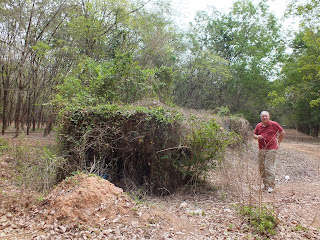Several weeks ago, my father, Bishop Holliman, b. December 17, 1919, in Irondale, Alabama, returned to his childhood home to visit his niece, Mary Daly Herrin. Dad now lives in Avilla, Indiana, just north of Fort Wayne. That is the childhood home of his wife, Ellen Parks Cox Holliman. They have been married for sixteen years.
While I posted photographs that Mary's son David had emailed me, David's sister, Linda Herrin Bradley sent several more. Taken together, these deserve a more permanent place on this blog.

 On the left, right to left, Ellen, Bishop, Patti Holliman Hairston and Linda Herrin Bradley.
On the left, right to left, Ellen, Bishop, Patti Holliman Hairston and Linda Herrin Bradley. Patti is the daughter of Melton (1908-1958) and Ida Hughes Holliman (1905-1995) and Linda, the daughter of E.C. (1930-2015) and Mary Daly Herrin. Mary is far right in the right picture.
Patti and Mary are first cousins, both with numerous grandchildren. Mary, a matriarch of the extended family, is the daughter of Robert W. and Vena Holliman Daly. She is the first born grandchild of Ulyss (1884-1965) and Pearl Caine Holliman (1888-1955). Ulyss and Pearl were born in Fayette County, Alabama, married there in 1906, farmed and around 1917 moved to Irondale, Alabama.
Irondale was a growing suburb of Birmingham, a city then exploding in population due to its steel industry and World War I. Ulyss, who had wood working experience, went to work for the Birmingham Electric Company which ran the street car lines. The trolleys were then wood frame with wooden benches. In 1921, a large family house was constructed at 2300 3rd Avenue North in Irondale sans painting and running water. There tw0 children were born and seven grew to adulthood. This writer in 1946 spent the first two weeks of his life in the house with Grandmother Holliman teaching my mother, Geraldine Stansbery Holliman Feick (1923-2015) how to be take care of a wiggly, loud infant.
The day before the above pictures were taken, Ralph Holliman (b 1924) and his wife, Laura, living in Gulf Shores, Alabama drove up to Birmingham for the reunion. Bishop and Ralph are pictured below. The ladies left to right are Ellen, Bishop's wife, Mary and Laura Mills Holliman, Ralph's wife.
In the picture below, Mary's two sons - David (b 1964), left, and Clayton Herrin (b 1953), far right, join their great uncles in group pose.
Bishop and Ralph are the two surviving children of Ulyss and Pearl who had seven children between 1908 and 1924. The children who have passed away are Melton, Vena (1909-1990), Euhal (1912-1989), Loudelle (1914-1998) and Virginia (1922-2011).
Writers have called the generation of these seven children 'The Greatest Generation' because they survived the Great Depression, fought World War II and helped build the largest economy in the world. To all my aunts and uncles, I tip my hat and thank them for raising the 18 grandchildren of Ulyss and Pearl!


















































